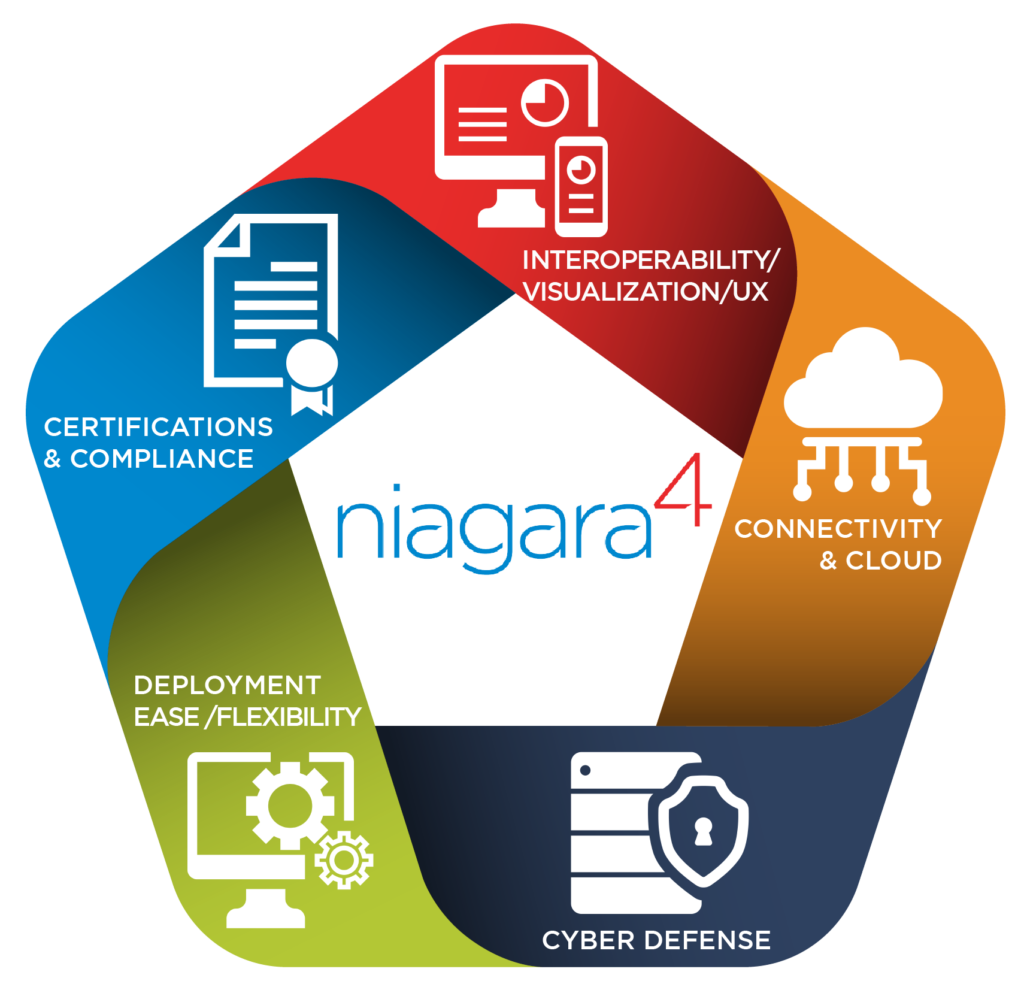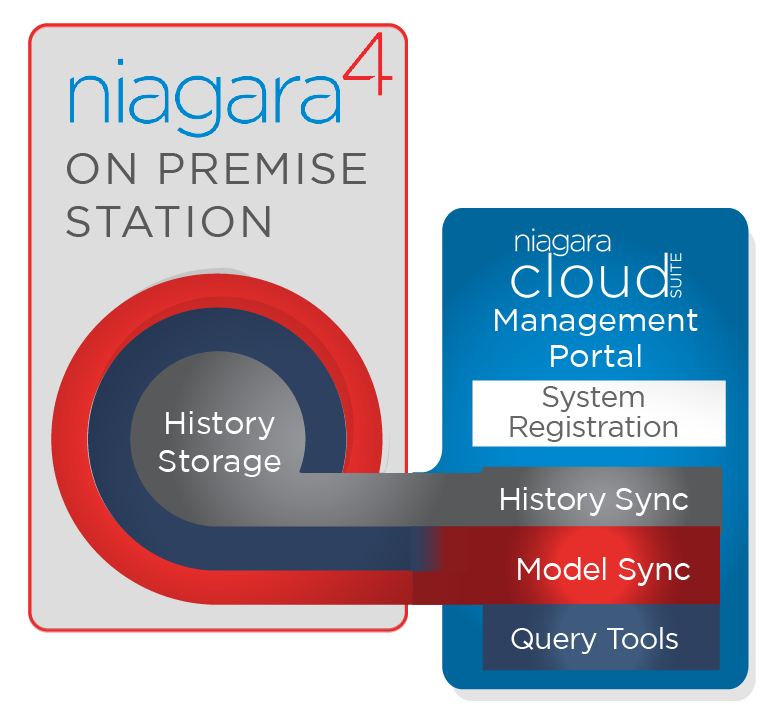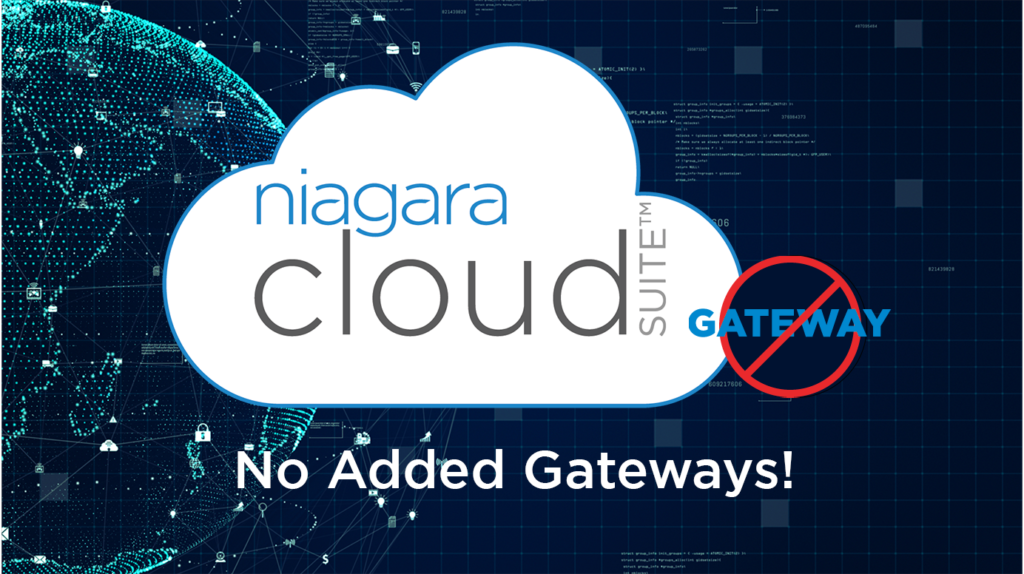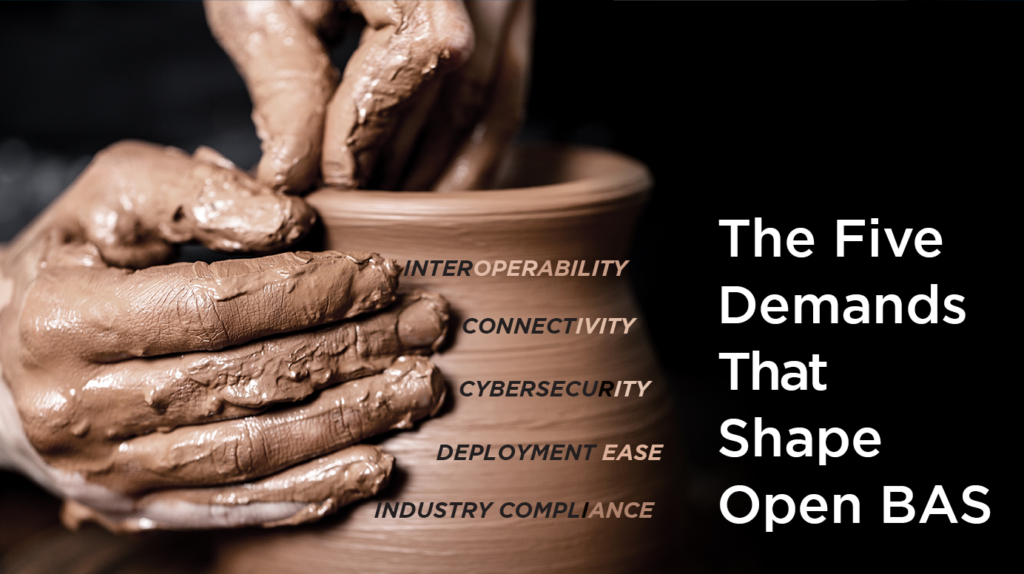Tridium has just launched its first SaaS offering from the Niagara Cloud Suite™ – and we’ve done it in a way that reinforces all five aspects of our commitment to Open building automation. Come to these sessions during AHR to learn more about how Tridium is approaching ‘BAS in the Cloud, the Future of Industry’, ‘Cyber Security for Building Automation Systems’ and ‘The Move from Smart Buildings to Smarter Buildings’.
“What is an open Building Automation platform?” Breaking it down, you can answer that question in terms of the benefits sought and services demanded of a BAS from the design engineers that specify it, the system integrators that deploy it, and the facility managers and building operations teams that depend on it day-to-day. With over 25 years responding to those demands from Niagara Community members around the globe, Tridium answers that question in terms of five Demand, or Benefit, categories: Connectivity, Data Interoperability, Cybersecurity, Deployment Ease, and Compliance.

Every time we spin up a new release of the Niagara Framework® we evolve our platform along those five vectors — and Tridium has done that 12X, just since 2015 when Niagara 4 was introduced. Tridium has just released its first Software-as-a-Service offering built on a new cloud infrastructure, Niagara Cloud Suite™. Niagara Data Service™ holds potential to significantly accelerate and expand value delivery in every category and to pull many more partners, projects, and end-customers into the Niagara Community. Importantly, the Tridium cloud strategy doesn’t deviate from the 5-vector formula that has served us so far. It fits a hybrid cloud/on-premises BAS paradigm that ensures cloud and local activities are always complementary and in-sync, And, it maintains our open go-to-market approach by supporting the systems integration and solution development services of our partners, as well as the strategies and software choices of end-customers.
CONNECTIVITY
The words we use to label the demand-benefit categories of an open BAS are each short-hand. There are meanings embedded in them from decades of use and they frequently need to be redefined for a new context. Delivering ‘Connectivity’ for example, has meant having a large library of plug-and-play software drivers for controlling the physical or virtual hardware equipment and devices that an integrator is likely to meet in a building. The Niagara Community has helped Tridium maintain a large and robust driver collection which you can check out here.
While some assume the question is settled, and all Connectivity today is IP-connectivity, you can see from that list that RS-485 is still broadly used in buildings and industrial devices even if it is older than the Ethernet. A building automation platform needs to support connection to legacy equipment that doesn’t get replaced easily — eg, HVAC roof-top-units —as well newer, faster-adapting areas of building service — eg, access control equipment that may be exclusively IP-connected. There are many IP-controllers on the market today used to control HVAC, lighting and other services; but, the category of access control is one place where you can observe Niagara Connectivity expanding and evolving. Tridium’s Niagara Enterprise Security offering is specifically designed to address the challenges of integrating access control into open BAS. As more users pull access control into their Niagara networks, the sections of our driver library offering easy plug-and-play connectivity to major-brand cameras and ID card readers is growing steadily.
You will also see in the Niagara-Compatible Drivers and Applications list that the Niagara Community has extended the platform’s connectivity options to third-party software suites. When it comes to third-party software, the ‘Connectivity’ question becomes “Is there an API?” Niagara Data Service™ takes our support for API connectivity to the next level. It is based on an API-First Architecture — the Niagara Cloud Suite™ — that aims to ease connectivity with any Niagara partner-built smart-building, smart-city, or smart-industry application or, for that matter, any enterprise software that a building owner or property manager might use for business.
Niagara Data Service does not represent a full pivot to the cloud, though it is a big leap in our ability to support API Connectivity. Listening to our users, it is clear that hybrid on-premise/cloud environments are here for the foreseeable future. So, Tridium has developed and is bringing this new service to the market in a manner that supports the seamless and complementary interworking of local and cloud infrastructure. How we intend to do that can be explained with a short spin around the other four categories in our Five-Demands model, highlighting how Niagara Data Service will significantly improve on Niagara Framework’s ability to deliver on each.
INTEROPERABILITY/UX
Data Interoperability is another two-word phrase packed with meaning. User Experience (UX) is a function of interoperability and here is why. Digital output is ‘interoperable’ if it arrives at its destination with its meaning intact, such that the next digital machine that needs to work with it doesn’t need to rebuild, cleanse, or guess about the context surrounding it. In the world of Open BAS, data interoperability means that trend data is stored and exchanged packaged with its meta data including the semantic tags assigned to it.

Whether on-premise or now in-the-cloud, Niagara 4 serves up histories that comprise trend data complete with associated tags. For example, a Niagara data model captures the trend value 72 along with the semantic tags RTU1, degrees, Fahrenheit, Richmond, VA, Outside Air, Building 51. Contextualized data is a facilitator and often a prerequisite to data visualizations, data analytics, machine-learning (ML), and AI. In its role providing an Independent Data Layer (IDL) for a full complement of Niagara-native and third-part applications, it is essential that the Niagara DBMS preserve the time investment users make in assigning tags. Interoperability, efficiency, and scalability depend on it!
This whitepaper traces the history of Niagara Framework’s support for Data Interoperability and explains why this service demand is so tightly interwoven with the topics of standard semantics for tags, tagging dictionaries and ontologies. Niagara developers have been building functionality into Niagara Framework® to make it easier and more intuitive for Niagara users to systematically tag all their Niagara Station components since the release of Niagara 4.0 in 2015. Niagara tagging support has been evolving along with Project Haystack and other ontology efforts, up to including the ability to capture machine-readable relationships among things.
We anticipate that the segment of the Niagara Community most interested in Niagara Data Service will be those who are already making the most of semantic tagging and have already pushed forward into the use of advanced analytics. And, we believe that there are many more Niagara system integrators, building engineers and connected-commissioning experts who will step up to these challenges once they have access to the flexibility and near-unlimited storage capabilities of the cloud.
CYBERSECURITY
Demand that an Open BAS offer state-of-the-art protections from cyber threats is another of the 5 core goals of the category. BAS-IT Convergence means that any operational technology (OT) added to networking infrastructure maintained by enterprise IT must meet enterprise-grade cybersecurity standards. Tridium has steadily improved the cyber defenses native to all Niagara products. Because cybersecurity is as much about people and processes as technology, we’ve also provided guidance to Niagara systems integrators, business partners, and facility managers to deploy control systems with a cybersecurity mindset.

The most common cybersecurity-related objection that IT teams voice against new smart-building software is against opening portals to their enterprise network to accommodate dedicated gateway hardware. Niagara Data Service eliminates this necessity by providing one cloud storage location from which multiple third-parties can access fully-contextualized data from Niagara Framework—in other words, one Independent Data Layer.
DEPLOYMENT EASE
With so many different building types, different user roles, and variations in the Design-Construction practices across regions, building a one-size-fits-all Open BAS is not in the realm of the possible. A simple human interface into such a complex set of possibilities is near impossible. Tridium works from the advantage of having so many Niagara Development Partners around the world that build their solutions atop the Niagara Framework, addressing the particular needs of user types, building types and local practices. The ease-of-deployment feature/functionality added to Niagara Framework with each release reflects the collective priorities and innovative thinking of this active set of partners, as well as that of Niagara’s large base of end-customers.
How intuitively and how efficiently can a Niagara user define a sequence of operations for a given set of building equipment? That’s one common ease-of-use benchmark. Certainly, having contextualized data with standardized, semantic tags and a rich library of plug-and-play connectivity options is a good start. We’ve discussed all that above under the Connectivity and Interoperability service demands. (No one said these categories don’t overlap.)
Now that Niagara has been ported to so many different brands and types of edge-controllers with their own local processing capabilities, the ability to software provision in bulk has become another ease-of use benchmark. This is a factor of the DBMS (data base management system) that underlies the BAS. Niagara Framework keeps improving its Bulk Deploy capability, and its System Database and indexing support multi-tier navigation. As of Niagara 4.13, users will be able to query an entire Niagara system from any location (supervisor or field-device-level instance) in the network. This flexibility will be a boon, especially to Niagara users overseeing many buildings in remote locations under Niagara control.
The ease of remote management of Niagara-controlled properties is improved further, given the new option of subscribing to Niagara Data Service. The Software as a Service (SaaS) delivery model eliminates deployment hurdles. The new option here is the ability to Pay-as-you-Go, counting the subscription as an Operational Expenditure (OpEx), rather than Capital Expenditure (CapEx). In some budgetary situations, this is a game-changer. Subscribers can fine-tune down to the trends they want, which can reduce complexity and ensure that they stay within the allowed egress of their subscription.
INDUSTRY COMPLIANCE
The greatest lesson to take from Niagara Framework’s decades-long journey toward leading in Open BAS is that each step gets you farther when done in collaboration with a highly engaged ecosystem of partners. Bringing to market a BAS that complies with the demands of this group is the existential challenge. Formal Compliance activities for Tridium involve working with standardization bodies like BACnet Testing Laboratories to ensure our software/hardware solutions meet the requirements to get an official BACnet Product Listing. Tridium operates its product development organization to security standards set by ISA 62443-3-3, Security Level 4 for Critical Infrastructure. Here’s a Niagara IT Primer Brochure that describes all the cybersecurity features added to Niagara 4 to comply with these guidelines.
Compliance demands can also come directly from customers. Certainly our government and military defense customers set a formal set of requirements for any operational technology solutions used in their buildings. For security reasons, they mandate that operational data not be moved or maintained off-premises. Governments and big enterprises have also grown averse to data-selling business models and they have added data-ownership requirements to their contracts. For both these reasons, some cloud-hosted software is out-of-compliance with this type of customer. On-premise mandates are why hybrid environments will exist for the foreseeable future which has driven Tridium’s goal of making Niagara local and cloud infrastructure work seamlessly. Further keeping Niagara Framework in compliance, Tridium’s new Niagara Data Service has been architected such that a copy of data can be stored locally and managed as archive. It’s up to user’s discretion to set parameters for data to be sent to the cloud – and Tridium does not own or use the end user’s data.



